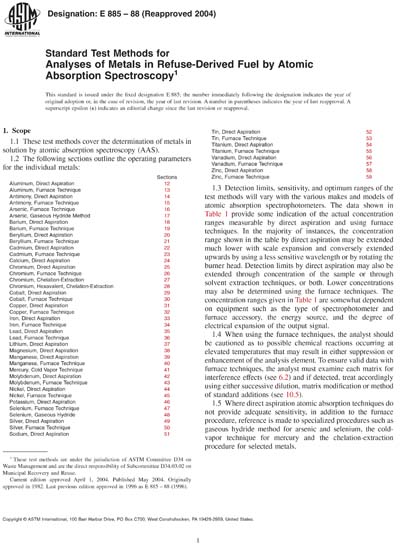Historical
ASTM E885-88(2004)
Standard Test Methods for Analyses of Metals in Refuse-Derived Fuel by Atomic Absorption Spectroscopy
1.1 These test methods cover the determination of metals in solution by atomic absorption spectroscopy (AAS).
1.2 The following sections outline the operating parameters for the individual metals:
1.3 Detection limits, sensitivity, and optimum ranges of the test methods will vary with the various makes and models of atomic absorption spectrophotometers. The data shown in provide some indication of the actual concentration ranges measurable by direct aspiration and using furnace techniques. In the majority of instances, the concentration range shown in the table by direct aspiration may be extended much lower with scale expansion and conversely extended upwards by using a less sensitive wavelength or by rotating the burner head. Detection limits by direct aspiration may also be extended through concentration of the sample or through solvent extraction techniques, or both. Lower concentrations may also be determined using the furnace techniques. The concentration ranges given in are somewhat dependent on equipment such as the type of spectrophotometer and furnace accessory, the energy source, and the degree of electrical expansion of the output signal.
1.4 When using the furnace techniques, the analyst should be cautioned as to possible chemical reactions occurring at elevated temperatures that may result in either suppression or enhancement of the analysis element. To ensure valid data with furnace techniques, the analyst must examine each matrix for interference effects (see ) and if detected, treat accordingly using either successive dilution, matrix modification or method of standard additions (see ).
1.5 Where direct aspiration atomic absorption techniques do not provide adequate sensitivity, in addition to the furnace procedure, reference is made to specialized procedures such as gaseous hydride method for arsenic and selenium, the cold-vapor technique for mercury and the chelation-extraction procedure for selected metals.
This standard does not purport to address all of the safety concerns, if any, associated with its use. It is the responsibility of the user of this standard to establish appropriate safety and health practices and determine the applicability of regulatory limitations prior to use.
ASTM International [astm]

